Pottery
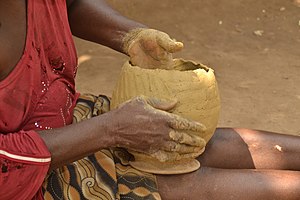
Potteryis the process and the products of forming vessels and other objects withclayand other raw materials, which are fired at high temperatures to give them a hard and durable form. The place where such wares are made by apotteris also called apottery(pluralpotteries). The definition ofpottery,used by theASTM International,is "all fired ceramic wares that contain clay when formed, except technical, structural, and refractory products".[1]End applications includetableware,decorative ware,sanitary ware,and intechnologyand industry such aselectrical insulatorsand laboratory ware. In art history andarchaeology,especially of ancient andprehistoricperiods, pottery often means only vessels, andsculptedfigurines of the same material are calledterracottas.[2]

Pottery is one of theoldest human inventions,originating before theNeolithic period,with ceramic objects such as theGravettiancultureVenus of Dolní Věstonicefigurine discovered in the Czech Republic dating back to 29,000–25,000 BC.[3]However, the earliest known potteryvesselswere discovered inJiangxi,China, which date back to 18,000 BC. Other earlyNeolithicand pre-Neolithic pottery artifacts have been found, inJōmonJapan (10,500 BC),[4]theRussian Far East(14,000 BC),[5]Sub-Saharan Africa(9,400 BC),[6]South America(9,000s–7,000s BC),[7]and theMiddle East(7,000s–6,000s BC).

Pottery is made by forming a clay body into objects of a desired shape and heating them to high temperatures (600–1600 °C) in abonfire,pit orkiln,which induces reactions that lead to permanent changes including increasing the strength and rigidity of the object. Much pottery is purely utilitarian, but some can also be regarded asceramic art.An article can bedecoratedbefore or after firing.
Pottery is traditionally divided into three types:earthenware,stonewareandporcelain.All three may beglazedand unglazed. All may also be decorated by various techniques. In many examples the group a piece belongs to is immediately visually apparent, but this is not always the case; for examplefritwareuses no or little clay, so falls outside these groups. Historic pottery of all these types is often grouped as either "fine" wares, relatively expensive and well-made, and following the aesthetic taste of the culture concerned, or alternatively "coarse", "popular", "folk" or "village" wares, mostly undecorated, or simply so, and often less well-made.
Cookingin pottery became less popular once metal pots became available,[8]but is still used for dishes that benefit from the qualities of pottery cooking, typically slow cooking in an oven, such asbiryani,cassoulet,daube,tagine,jollof rice,kedjenou,cazuelaand types ofbaked beans.[8]
Main types
[edit]Earthenware
[edit]
The earliest forms of pottery were made from clays that were fired at low temperatures, initially in pit-fires or in openbonfires.They were hand formed and undecorated. Earthenware can be fired as low as 600 °C, and is normally fired below 1200 °C.[9]
Because unglazed earthenware is porous, it has limited utility for the storage of liquids or as tableware. However, earthenware has had a continuous history from theNeolithicperiod to today. It can be made from a wide variety of clays, some of which fire to a buff, brown or black colour, with iron in the constituent minerals resulting in a reddish-brown. Reddish coloured varieties are calledterracotta,especially when unglazed or used for sculpture. The development ofceramic glazemade impermeable pottery possible, improving the popularity and practicality of pottery vessels. Decoration has evolved and developed through history.
Stoneware
[edit]
Stoneware is pottery that has been fired in a kiln at a relatively high temperature, from about 1,100 °C to 1,200 °C, and is stronger and non-porous to liquids.[10]The Chinese, who developed stoneware very early on, classify this together with porcelain as high-fired wares. In contrast, stoneware could only be produced in Europe from the late Middle Ages, as European kilns were less efficient, and the right type of clay less common. It remained a speciality ofGermanyuntil the Renaissance.[11]
Stoneware is very tough and practical, and much of it has always been utilitarian, for the kitchen or storage rather than the table. But "fine" stoneware has been important inChina,Japanand the West, and continues to be made. Many utilitarian types have also come to be appreciated as art.
Porcelain
[edit]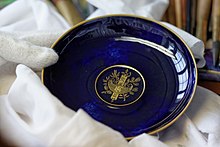
Porcelainis made by heating materials, generally includingkaolin,in akilnto temperatures between 1,200 and 1,400 °C (2,200 and 2,600 °F). This is higher than used for the other types, and achieving these temperatures was a long struggle, as well as realizing what materials were needed. The toughness, strength and translucence of porcelain, relative to other types of pottery, arises mainly fromvitrificationand the formation of the mineralmullitewithin the body at these high temperatures.
Although porcelain was first made inChina,the Chinese traditionally do not recognise it as a distinct category, grouping it with stoneware as "high-fired" ware, opposed to "low-fired" earthenware. This confuses the issue of when it was first made. A degree of translucency and whiteness was achieved by theTang dynasty(AD 618–906), and considerable quantities were being exported. The modern level of whiteness was not reached until much later, in the 14th century. Porcelain was also made inKoreaand inJapanfrom the end of the 16th century, after suitable kaolin was located in those countries. It was not made effectively outside East Asia until the 18th century.[12]
Archaeology
[edit]
The study of pottery can help to provide an insight into past cultures. Fabric analysis (see section below), used to analyse thefabric of pottery,is important part of archaeology for understanding thearchaeological cultureof the excavated site by studying the fabric of artifacts, such as their usage, source material composition, decorative pattern, color of patterns, etc. This helps to understand characteristics,sophistication,habits, technology, tools, trade, etc. of the people who made and used the pottery.Carbon datingreveals the age. Sites with similar pottery characteristics have the same culture, those sites which have distinct cultural characteristics but with some overlap are indicative of cultural exchange such as trade or living in vicinity or continuity of habitation, etc. Examples areblack and red ware,redware,Sothi-Siswal cultureandPainted Grey Ware culture.Thesix fabrics of Kalibanganis a good example of use of fabric analysis in identifying a differentiated culture which was earlier thought to be typicalIndus Valley civilisation(IVC) culture.
Pottery is durable, and fragments, at least, often survive long after artifacts made from less-durable materials have decayed past recognition. Combined with other evidence, the study of pottery artefacts is helpful in the development of theories on the organisation, economic condition and the cultural development of the societies that produced or acquired pottery. The study of pottery may also allow inferences to be drawn about a culture's daily life, religion, social relationships, attitudes towards neighbours, attitudes to their own world and even the way the culture understood the universe.

It is valuable to look into pottery as an archaeological record of potential interaction between peoples. When pottery is placed within the context of linguistic and migratory patterns, it becomes an even more prevalent category of social artifact.[13]As proposed by Olivier P. Gosselain, it is possible to understand ranges of cross-cultural interaction by looking closely at thechaîne opératoireof ceramic production.[14]
The methods used to produce pottery in early Sub-Saharan Africa are divisible into three categories: techniques visible to the eye (decoration, firing and post-firing techniques), techniques related to the materials (selection or processing of clay, etc.), and techniques of molding or fashioning the clay.[14]These three categories can be used to consider the implications of the reoccurrence of a particular sort of pottery in different areas. Generally, the techniques that are easily visible (the first category of those mentioned above) are thus readily imitated, and may indicate a more distant connection between groups, such as trade in the same market or even relatively close settlements.[14]Techniques that require more studied replication (i.e., the selection of clay and the fashioning of clay) may indicate a closer connection between peoples, as these methods are usually only transmissible between potters and those otherwise directly involved in production.[14]Such a relationship requires the ability of the involved parties to communicate effectively, implying pre-existing norms of contact or a shared language between the two. Thus, the patterns of technical diffusion in pot-making that are visible via archaeological findings also reveal patterns in societal interaction.
Chronologies based on pottery are often essential for dating non-literate cultures and are often of help in the dating of historic cultures as well.Trace-element analysis,mostly byneutron activation,allows the sources of clay to be accurately identified and thethermoluminescencetest can be used to provide an estimate of the date of last firing. Examiningsherdsfrom prehistory, scientists learned that during high-temperature firing, iron materials in clay record the state of theEarth's magnetic fieldat that moment.
Fabric analysis
[edit]The"clay body"is also called the"paste"or the"fabric",which consists of 2 things, the"clay matrix"– composed of grains of less than 0.02 mm grains which can be seen using the high-powered microscopes or ascanning electron microscope,and the"clay inclusions"– which are larger grains of clay and could be seen with the naked eye or a low-power binocular microscope. For geologists, fabric analysis means spatial arrangement of minerals in a rock. For Archaeologists, the"fabric analysis"of pottery entails the study ofclay matrixandinclusionsin the clay body as well as thefiring temperature and conditions.Analysis is done to examine the following 3 in detail:[15]
- How pottery was made e.g. material, design such as shape and style, etc.
- Its decorations, such as patterns, colors of patterns, slipped (glazing) or unslipped decoration
- Evidence of type of use.
TheSix fabrics of Kalibanganis a good example of fabric analysis.
Clay bodies and raw materials
[edit]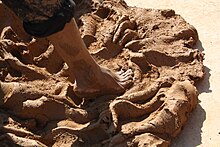

Body,or clay body, is the material used to form pottery. Thus a potter might prepare, or order from a supplier, such an amount of earthenware body, stoneware body or porcelain body. The compositions of clay bodies varies considerably, and include both prepared and 'as dug'; the former being by far the dominant type for studio and industry. The properties also vary considerably, and includeplasticityand mechanical strength before firing; the firing temperature needed to mature them; properties after firing, such as permeability, mechanical strength and colour.
There can be regional variations in the properties of raw materials used for pottery, and these can lead to wares that are unique in character to a locality.
The main ingredient of the body isclay.Some different types used for pottery include:[16]
- Kaolin,sometimes referred to aschina clay,is a key ingredient inporcelain,which was first used in China around the 7th and 8th centuries.[17]
- Ball clay:An extremely plastic, fine grainedsedimentaryclay, which may contain some organic matter.
- Fire clay:A clay having a slightly lower percentage offluxesthan kaolin, but usually quite plastic. It is highly heat resistant form of clay which can be combined with other clays to increase the firing temperature and may be used as an ingredient to make stoneware type bodies.
- Stoneware clay: Suitable for creating stoneware. Has many of the characteristics between fire clay and ball clay, having finer grain, like ball clay but is more heat resistant like fire clays.
- Common red clay andshaleclay have vegetable and ferric oxide impurities which make them useful for bricks, but are generally unsatisfactory for pottery except under special conditions of a particular deposit.[18]
- Bentonite:An extremely plastic clay which can be added in small quantities to short clay to increase the plasticity.
It is common for clays and other raw materials to be mixed to produce clay bodies suited to specific purposes. Variousmineral processingtechniques are often utilised before mixing the raw materials, withcomminutionbeing effectively universal for non-clay materials.
Examples of non-clay materials include:
- Feldspar,act asfluxeswhich lower thevitrificationtemperature of bodies.
- Quartz,an important role is to attenuate drying shrinkage.

- Nepheline syenite,an alternative to feldspar.
- Calcined alumina,can enhance the fired properties of a body.
- Chamotte, also called grog, is fired clay which it is crushed, and sometimes then milled. Helps attenuate drying shrinkage.[19]
- Bone ash,produced by thecalcinationof animalbone.A key raw material for bone china.
- Frit,produced made by quenching and breaking up a glass of a specific composition. Can be used at low additions in some bodies, but common uses include as components of a glaze or enamel, or for the body offritware,when it usually mixed with larger quantities of quartz sand.
- Various others at low levels of addition such asdolomite,limestone,talcandwollastonite.
Production
[edit]The production of pottery includes the following stages:

- Preparing the clay body.
- Shaping
- Drying
- Firing
- Glazing and decorating. (this can be undertaken prior to firing. Also, additional firing stages after decoration may be needed.)
Shaping
[edit]Before being shaped, clay must be prepared. This may includekneadingto ensure an even moisture content throughout the body. Air trapped within the clay body needs to be removed, or de-aired, and can be accomplished either by a machine called a vacuumpugor manually bywedging.Wedging can also help produce an even moisture content. Once a clay body has been kneaded and de-aired or wedged, it is shaped by a variety of techniques, which include:
- Hand-building: This is the earliest forming method. Wares can be constructed by hand fromcoils of clay,combining flat slabs of clay, orpinchingsolid balls of clay or some combination of these. Parts of hand-built vessels are often joined with the aid ofslip.Somestudio pottersfind hand-building more conducive for one-of-a-kind works ofart.
A potter using a potter's wheel describes his materials (in Romanian and English) - Thepotter's wheel:In a process called "throwing" (coming from theOld Englishwordthrawanwhich means to twist or turn,[20]) a ball of clay is placed in the centre of a turntable, called the wheel-head, which the potter rotates with a stick, with foot power or with a variable-speedelectric motor.During the process of throwing, the wheel rotates while the solid ball of soft clay is pressed, squeezed and pulled gently upwards and outwards into a hollow shape. Skill and experience are required to throw pots of an acceptable standard and, while the ware may have high artistic merit, the reproducibility of the method is poor.[21]Because of its inherent limitations, throwing can only be used to create wares withradial symmetryon avertical axis.
- Press moulding: a simple technique of shaping by manually pressing a lump of clay body into a porous mould.[22][23][24]
- Granulate pressing: a highly automated technique of shaping by pressing clay body in a semi-dry and granulated form in amould.The body is pressed into the mould by a porous die through which water is pumped at high pressure. The fine, free flowinggranulatedbody is prepared byspray dryinga high-solids content slip. Granulate pressing, also known asdust pressing,is widely used in the manufacture ofceramic tilesand, increasingly, of plates.[25][26][27]
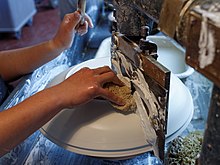
Jiggering a plate - Jiggering and jolleying:These operations are carried out on the potter's wheel and allow the time taken to bring wares to a standardized form to be reduced.Jiggeringis the operation of bringing a shaped tool into contact with the plastic clay of a piece under construction, the piece itself being set on a rotating plaster mould on the wheel. The jigger tool shapes one face while the mould shapes the other. Jiggering is used only in the production of flat wares, such as plates, but a similar operation,jolleying,is used in the production of hollow-wares such as cups. Jiggering and jolleying have been used in the production of pottery since at least the 18th century. In large-scale factory production, jiggering and jolleying are usually automated, which allows the operations to be carried out by semi-skilled labour.
- Roller-head machine:This machine is for shaping wares on a rotating mould, as in jiggering and jolleying, but with a rotary shaping tool replacing the fixed profile. The rotary shaping tool is a shallow cone having the same diameter as the ware being formed and shaped to the desired form of the back of the article being made. Wares may in this way be shaped, using relatively unskilled labour, in one operation at a rate of about twelve pieces per minute, though this varies with the size of the articles being produced. Developed in the UK just afterWorld War IIby the companyService Engineers,roller-heads were quickly adopted by manufacturers around the world; it remains the dominant method for producing both flatware and holloware, such as plates and mugs.[28]
- Pressure casting: Is a development of traditional slipcasting. Specially developedpolymeric materialsallow a mould to be subject to application external pressures of up to 4.0 MPa – so much higher than slip casting in plaster moulds where the capillary forces correspond to a pressure of around 0.1–0.2 MPa. The high pressure leads to much faster casting rates and, hence, faster production cycles. Furthermore, the application of high pressure air through the polymeric moulds upon demoulding the cast means a new casting cycle can be started immediately in the same mould, unlike plaster moulds which require lengthy drying times. The polymeric materials have much greater durability than plaster and, therefore, it is possible to achieve shaped products with better dimensional tolerances and much longer mould life. Pressure casting was developed in the 1970s for the production of sanitaryware although, more recently, it has been applied to tableware.[29][30][31][32]
- RAM pressing:This is used to shape ware by pressing a bat of prepared clay body into a required shape between two porous moulding plates. After pressing, compressed air is blown through the porous mould plates to release the shaped wares.[33]

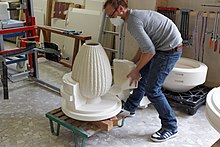
- Slip casting:This is suited to the making of shapes that cannot be formed by other methods. A liquidslip,made by mixingclaybody with water, is poured into a highly absorbent plaster mould. Water from the slip is absorbed into the mould leaving a layer of clay body covering its internal surfaces and taking its internal shape. Excess slip is poured out of the mould, which is then split open and the moulded object removed. Slip casting is widely used in the production of sanitaryware and is also used for making other complex shaped ware such as teapots and figurines.
- Injection moulding:This is a shape-forming process adapted for the tableware industry from the method long established for the forming ofthermoplasticand some metal components.[34]It has been calledPorcelain Injection Moulding,orPIM.[35]Suited to the mass production of complex-shaped articles, one significant advantage of the technique is that it allows the production of acup,including the handle, in a single process, and thereby eliminates the handle-fixing operation and produces a stronger bond between cup and handle.[36]The feed to the mould die is a mix of approximately 50 to 60 per cent unfired body in powder form, together with 40 to 50 per cent organic additives composed ofbinders,lubricantsandplasticisers.[35]The technique is not as widely used as other shaping methods.[37]
- 3D printing:There are two methods. One involves the layered deposition of soft clay body similar to fused deposition modelling (FDM), and the other uses powder binding techniques where clay body in dry powder form is fused together layer upon layer with a liquid.[38][39]
- Injection mouldingof ceramic tableware has been developed, though it has yet to be fully commercialised.[40]
Drying
[edit]Prior to firing, the water in an article needs to be removed. A number of different stages, or conditions of the article, can be identified:
- Greenwarerefers to unfired objects at any stage of dryness, but is most often used to refer to objects ready to be fired. At sufficient moisture content, bodies at this stage are in their most plastic form (as they are soft and malleable, and hence can be easily deformed by handling). Prior to firing, any state of clay may be hydrated or dehydrated into any other unfired stage.
- Plastic,also known asWet,refers to clay that is malleable and sufficiently wet to shape by hand or on a potter's wheel, but strong enough to hold its shape. At this stage the clay has between 20% and 25% moisture content.[41]This is the stage most commercial clays are sold at, and at which most of the shaping process is done.
- Leather-hardrefers to a clay body that has been dried partially. At this stage the clay object has approximately 15% moisture content. Clay bodies at this stage are very firm and only slightly pliable. Trimming and handle attachment often occurs at the leather-hard state.
- Bone-dryrefers to clay bodies when they reach a moisture content at or near 0%. At that moisture content, the item is ready to be fired. Additionally, the piece is extremely brittle at this stage and must be handled with care.[42][43]
Firing
[edit]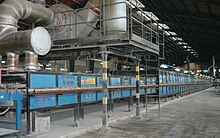
Firing produces permanent and irreversible chemical and physical changes in the body. It is only after firing that the article or material is pottery. In lower-fired pottery, the changes includesintering,the fusing together of coarser particles in the body at their points of contact with each other. In the case of porcelain, where higher firing-temperatures are used, the physical, chemical and mineralogical properties of the constituents in the body are greatly altered. In all cases, the reason for firing is to permanently harden the wares, and the firing regime must be appropriate to the materials used.
Temperature
[edit]As a rough guide, modern earthenwares are normally fired at temperatures in the range of about 1,000°C(1,830 °F) to 1,200 °C (2,190 °F); stonewares at between about 1,100 °C (2,010 °F) to 1,300 °C (2,370 °F); and porcelains at between about 1,200 °C (2,190 °F) to 1,400 °C (2,550 °F). Historically, reaching high temperatures was a long-lasting challenge, and earthenware can be fired effectively as low as 600 °C (1,112 °F), achievable in primitivepit firing.The time spent at any particular temperature is also important, the combination of heat and time is known asheatwork.
Kilnscan be monitored bypyrometers,thermocouplesandpyrometric devices.
Atmosphere
[edit]
The atmosphere within a kiln during firing can affect the appearance of the body and glaze. Key to this is the differing colours of the various oxides of iron, such asiron(III) oxide(also known as ferric oxide or Fe2O3) which is associated with brown-red colours, whilstiron(II) oxide(also known as ferrous oxide or FeO) is associated with much darker colours, including black. The oxygen concentration in the kiln influences the type, and relative proportions, of these iron oxides in fired the body and glaze: for example, where there is a lack of oxygen during firing the associatedcarbon monoxide(CO) will readily react with oxygen in Fe2O3in the raw materials and cause it to be reduced to FeO.[44][45]
An oxygen deficient condition, called a reducing atmosphere, is generated by preventing the complete combustion of the kiln fuel; this is achieved by deliberately restricting the supply of air or by supplying an excess of fuel.[44][45]
Methods
[edit]Firing pottery can be done using a variety of methods, with akilnbeing the usual firing method. Both the maximum temperature and the duration of firing influences the final characteristics of the ceramic. Thus, the maximum temperature within a kiln is often held constant for a period of time tosoakthe wares to produce the maturity required in the body of the wares.
Kilns may be heated by burning combustible materials, such aswood,coalandgas,or byelectricity.The use of microwave energy has been investigated.[46]
When used as fuels, coal and wood can introduce smoke, soot and ash into the kiln which can affect the appearance of unprotected wares. For this reason, wares fired in wood- or coal-fired kilns are often placed in the kiln insaggars,ceramic boxes, to protect them. Modern kilns fuelled by gas or electricity are cleaner and more easily controlled than older wood- or coal-fired kilns and often allow shorter firing times to be used.
Niche techniques include:
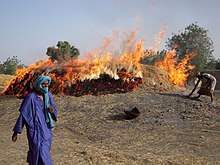
- In a Western adaptation of traditional JapaneseRaku warefiring, wares are removed from the kiln while hot and smothered in ashes, paper or woodchips which produces a distinctivecarbonisedappearance. This technique is also used in Malaysia in creating traditionallabu sayung.[47][48]
- InMali,a firing mound is used rather than a brick or stone kiln. Unfired pots are first brought to the place where a mound will be built, customarily by the women and girls of the village. The mound's foundation is made by placing sticks on the ground, then:
[...] pots are positioned on and amid the branches and then grass is piled high to complete the mound. Although the mound contains the pots of many women, who are related through their husbands' extended families, each women is responsible for her own or her immediate family's pots within the mound. When a mound is completed and the ground around has been swept clean of residual combustible material, a senior potter lights the fire. A handful of grass is lit and the woman runs around the circumference of the mound touching the burning torch to the dried grass. Some mounds are still being constructed as others are already burning.[49]
Stages
[edit]- Biscuit(or bisque)[50][51]refers to the clay after the object is shaped to the desired form and fired in the kiln for the first time, known as "bisque fired" or "biscuit fired". This firing results in both chemical and physical changes to the minerals of the clay body.
- Glaze firedis the final stage of some pottery making, orglost fired.[21]Aglazemay be applied to the biscuit ware and the object can be decorated in several ways. After this the object is "glazed fired", which causes the glaze material to melt, then adhere to the object. Depending on the temperature schedule the glaze firing may also further mature the body as chemical and physical changes continue.
Decorating
[edit]Pottery may be decorated in many different ways. Some decoration can be done before or after the firing, and may be undertaken before or after glazing.
Methods
[edit]
- Painting has been used since early prehistoric times, and can be very elaborate. The painting is often applied to pottery that has been fired once, and may then be overlaid with a glaze afterwards. Manypigmentschange colour when fired, and the painter must allow for this.
- Glaze:Perhaps the most common form of decoration, that also serves as protection to the pottery, by being tougher and keeping liquid from penetrating the pottery. Glaze may be colourless, especially over painting, or coloured and opaque.
- Crystalline glaze: acharacterised by crystalline clusters of various shapes and colours embedded in a more uniform and opaque glaze. Produced by the slow cooling of the glost fire.
- Carving:Pottery vessels may be decorated by shallow carving of the clay body, typically with a knife or similar instrument used on the wheel. This is common in Chinese porcelain of the classic periods.
- Burnishing:The surface of pottery wares may beburnishedprior to firing by rubbing with a suitable instrument of wood, steel or stone to produce a polished finish that survives firing. It is possible to produce very highly polished wares when fine clays are used or when the polishing is carried out on wares that have been partially dried and contain little water, though wares in this condition are extremely fragile and the risk of breakage is high.
- Terra Sigillatais an ancient form of decorating ceramics that was first developed in Ancient Greece.
- Lithography,also called litho, although the alternative names oftransfer printor "decal"are also common. These are used to apply designs to articles. The litho comprises three layers: the colour, or image, layer which comprises the decorative design; the cover coat, a clear protective layer, which may incorporate a low-melting glass; and the backing paper on which the design is printed by screen printing or lithography. There are various methods of transferring the design while removing the backing-paper, some of which are suited to machine application.
- Banding is the application by hand or by machine of a band of colour to the edge of a plate or cup. Also known as "lining", this operation is often carried out on a potter's wheel.
- Agateware:named after its resemblance to the mineralagate,is produced by partially blending clays of differing colours. In Japan the term "neriage"is used, whilst in China, where such things have been made since at least theTang dynasty,they are called "marbled"wares.
- Engobe:aclay slipis used to coat the surface of pottery, usually before firing. Its purpose is often decorative though it can also be used to mask undesirable features in the clay to which it is applied. The engobe may be applied by painting or by dipping to provide a uniform, smooth, coating. Such decoration is characteristic ofslipware.Forsgraffitodecoration a layer of engobe is scratched through to reveal the underlying clay.
- Gold: Decoration with gold is used on some high quality ware. Different methods exist for its application, including:

- Best gold– a suspension of gold powder in essential oils mixed with a flux and a mercury salt extended. This can be applied by a painting technique. From the kiln, the decoration is dull and requires burnishing to reveal the full colour
- Acid Gold– a form of gold decoration developed in the early 1860s at the English factory ofMintons Ltd.The glazed surface is etched with dilutedhydrofluoric acidprior to application of the gold. The process demands great skill and is used for the decoration only of ware of the highest class.
- Bright Gold– consists of a solution of gold sulphoresinate together with other metal resonates and a flux. The name derives from the appearance of the decoration immediately after removal from the kiln as it requires no burnishing
- Mussel Gold– an old method of gold decoration. It was made by rubbing together gold leaf, sugar and salt, followed by washing to remove solubles
- Underglazedecoration is applied, by a number of techniques, onto ware before it is glazed, an example isblue and white wares.Can be applied by a number of techniques.
- In-glaze decoration,is applied on the surface of theglazebefore theglost firing.
- On-glaze decorationis applied on top of the already fired, glazed surface, and then fixed in a second firing at a relatively low temperature.
Glazing
[edit]
Glaze is a glassy coating on pottery, and reasons to use it include decoration, ensuring the item is impermeable to liquids, and minimizing the adherence of pollutants.
Glaze may be applied by spraying, dipping, trailing or brushing on an aqueous suspension of the unfired glaze. The colour of a glaze after it has been fired may be significantly different from before firing. To prevent glazed wares sticking tokiln furnitureduring firing, either a small part of the object being fired (for example, the foot) is left unglazed or, alternatively, special refractory "spurs"are used as supports. These are removed and discarded after the firing.
Some specialised glazing techniques include:
- Salt-glazing–common saltis introduced to the kiln during the firing process. The high temperatures cause the salt to volatilise, depositing it on the surface of the ware to react with the body to form a sodium aluminosilicate glaze. In the 17th and 18th centuries, salt-glazing was used in the manufacture of domestic pottery. Now, except for use by some studio potters, the process is obsolete. The last large-scale application before its demise in the face of environmental clean air restrictions was in the production of salt-glazedsewer-pipes.[52][53]

- Ash glazing– ash from the combustion of plant matter has been used as the flux component of glazes. The source of the ash was generally the combustion waste from the fuelling of kilns although the potential of ash derived from arable crop wastes has been investigated.[54]Ash glazes are of historical interest in the Far East although there are reports of small-scale use in other locations such as theCatawba Valley Potteryin the United States. They are now limited to small numbers of studio potters who value the unpredictability arising from the variable nature of the raw material.[55]
Health and environmental issues
[edit]Although many of the environmental effects of pottery production have existed for millennia, some of these have been amplified with modern technology and scales of production. The principal factors for consideration fall into two categories:
- Effects on workers: Notable risks includesilicosis,heavy metal poisoning,poorindoor air quality,dangerous sound levelsand possibleover-illumination.
- Effects on the general environment.
Historically,lead poisoning(plumbism) was a significant health concern to those glazing pottery. This was recognised at least as early as the nineteenth century. The first legislation in the UK to limit pottery workers exposure to lead was included in theFactories Act Extension Act in 1864,with further introduced in 1899.[56][57]
Silicosisis anoccupational lung diseasecaused by inhaling large amounts of crystalline silica dust, usually over many years. Workers in the ceramic industry can develop it due to exposure tosilicadust in the raw materials; colloquially it has been known as 'Potter's rot'. Less than 10 years after its introduction, in 1720, as a raw material to the British ceramics industry the negative effects of calcined flint on the lungs of workers had been noted.[58]In one study reported in 2022, of 106 UK pottery workers 55 per cent had at least some stage of silicosis.[59][60][61]Exposure to siliceous dusts is reduced by either processing and using the source materials as aqueous suspension or as damp solids, or by the use of dust control measures such asLocal exhaust ventilation.These have been mandated by legislation, such asThe Pottery (Health and Welfare) Special Regulations 1950.[62][63] TheHealth and Safety Executivein the UK has producedguidelineson controlling exposure to respirable crystalline silica in potteries, and the British Ceramics Federation provide, as a free download, aguidance booklet.Archived2023-04-19 at theWayback Machine
Environmental concerns include off-sitewater pollution,air pollution,disposal ofhazardous materials,disposal of rejected ware and fuel consumption.[64]
History
[edit]A great part of the history of pottery isprehistoric,part of past pre-literate cultures. Therefore, much of this history can only be found among theartifactsofarchaeology.Because pottery is so durable, pottery andshardsof pottery survive for millennia atarchaeological sites,and are typically the most common and important type of artifact to survive. Many prehistoric cultures are named after the pottery that is the easiest way to identify their sites, and archaeologists develop the ability to recognise different types from the chemistry of small shards.
Before pottery becomes part of a culture, several conditions must generally be met.
- First, there must be usable clay available. Archaeological sites where the earliest pottery was found were near deposits of readily available clay that could be properly shaped and fired. China has large deposits of a variety of clay, which gave them an advantage in early development of fine pottery. Many countries have large deposits of a variety of clay.
- Second, it must be possible to heat the pottery to temperatures that will achieve the transformation from raw clay to ceramic. Methods to reliably create fires hot enough tofire potterydid not develop until late in the development of cultures.
- Third, the potter must have time available to prepare, shape and fire the clay into pottery. Even after control of fire was achieved, humans did not seem to develop pottery until asedentary lifewas achieved. It has been hypothesized that pottery was developed only after humans established agriculture, which led to permanent settlements. However, theoldest known potteryis from the Czech Republic and dates to 28,000 BC, at the height of the most recent ice age, long before the beginnings of agriculture.
- Fourth, there must be a sufficient need for pottery in order to justify the resources required for its production.[65]
Early pottery

- Methods of forming: Hand-shaping was the earliest method used to form vessels. This included the combination ofpinchingandcoiling.
- Firing: The earliest method for firing pottery wares was the use of bonfirespit fired pottery.Firing times might be short but the peak-temperatures achieved in thefirecould be high, perhaps in the region of 900 °C (1,650 °F), and were reached very quickly.[66]
- Clay: Early potters used whatever clay was available to them in their geographic vicinity. However, the lowest quality common red clay was adequate for low-temperature fires used for the earliest pots. Claytemperedwith sand, grit, crushed shell or crushed pottery were often used to make bonfire-fired ceramics because they provided an open-body texture that allowed water and volatile components of the clay to escape freely. The coarser particles in the clay also acted to restrain shrinkage during drying, and hence reduce the risk of cracking.
- Form: In the main, early bonfire-fired wares were made with rounded bottoms to avoid sharp angles that might be susceptible to cracking.
- Glazing: the earliest pots were not glazed.
- Thepotter's wheelwas invented inEuropein the 5th millennium BC, and revolutionised pottery production. Earliest potter's wheel dated to the middle of the 5th millennium BC from theCucuteni–Trypillia culturein western Ukraine.[67]
- Moulds were used to a limited extent as early as the 5th and 6th century BC by theEtruscans[68]and more extensively by the Romans.[69]
- Slipcasting,a popular method for shaping irregular shaped articles. It was first practised, to a limited extent, in China as early as theTang dynasty.[70]
- Transition to kilns: The earliest intentionally constructed werepit-kilnsor trench-kilns, holes dug in the ground and covered with fuel. Holes in the ground provided insulation and resulted in better control over firing.[71]
- Kilns:Pit fire methods were adequate for simple earthenware, but other pottery types needed more sophisticated kilns.
History by region
[edit]Beginnings of pottery
[edit]

Pottery may well have been discovered independently in various places, probably by accidentally creating it at the bottom of fires on a clay soil. The earliest-known ceramic objects areGravettianfigurines such as those discovered at Dolní Věstonice in the modern-day Czech Republic. TheVenus of Dolní Věstoniceis a Venus figurine, a statuette of a nude female figure dated to 29,000–25,000 BC (Gravettian industry).[3]But there is no evidence of pottery vessels from this period. Weightsfor loomsor fishing-nets are a very common use for the earliest pottery.Sherdshave been found in China and Japan from a period between 12,000 and perhaps as long as 18,000 years ago.[5][74]As of 2012, the earliest pottery vessels found anywhere in the world,[75]dating to 20,000 to 19,000 years before the present, was found atXianren Cavein the Jiangxi province of China.[76][77]
Other early pottery vessels include those excavated from theYuchanyan Cavein southern China, dated from 16,000 BC,[74]and those found in the Amur River basin in the Russian Far East, dated from 14,000 BC.[5][78]
TheOdai Yamamoto I site,belonging to theJōmon period,currently has the oldest pottery in Japan. Excavations in 1998 uncoveredearthenwarefragments which have been dated as early as 14,500 BC.[79] The term "Jōmon" means "cord-marked" in Japanese. This refers to the markings made on the vessels and figures using sticks with cords during their production. Recent research has elucidated howJōmon potterywas used by its creators.[80]
It appears that pottery was independently developed in Sub-Saharan Africa during the 10th millennium BC, with findings dating to at least 9,400 BC from centralMali,[6]and in South America during the 9,000s–7,000s BC.[81][7]The Malian finds date to the same period as similar finds from East Asia – the triangle between Siberia, China and Japan – and are associated in both regions to the same climatic changes (at the end of the ice age new grassland develops, enabling hunter-gatherers to expand their habitat), met independently by both cultures with similar developments: the creation of pottery for the storage of wild cereals (pearl millet), and that of small arrowheads for hunting small game typical of grassland.[6]Alternatively, the creation of pottery in the case of the Incipient Jōmon civilisation could be due to the intensive exploitation of freshwater and marine organisms by late glacial foragers, who started developing ceramic containers for their catch.[80]
East Asia
[edit]

In Japan, theJōmon periodhas a long history of development ofJōmon potterywhich was characterized by impressions of rope on the surface of the pottery created by pressing rope into the clay before firing. Glazed Stoneware was being created as early as the 15th century BC in China. A form ofChinese porcelainbecame a significant Chinese export from the Tang dynasty (AD 618–906) onwards.[10]Korean potters adopted porcelain as early as the 14th century AD.[82]The ceramic industry has developed greatly since theGoryeodynasty, andGoryeo ware,a celadon with unique inlaying techniques, was produced. Later, when white porcelain became common and celadon fell, they created unique ceramics such asBuncheong.Japan's white porcelain was influenced by potters kidnapped during theJapanese invasions of Korea (1592–1598),called The Ceramic Wars, and Japanese engineers introduced it during the Fall of the Ming dynasty's. Typically, Korean potters who settled in Arita pass on pottery techniques, Shonzui Goradoyu-go brought back the secret of its manufacture from the Chinese kilns at Jingdezhen.[83]
In contrast to Europe, the Chinese social elite used pottery extensively at table, for religious purposes, and for decoration, and the standards of fine pottery were very high. From theSong dynasty(960–1279) for several centuries, the tastes of Chinese elites favoured plain-coloured and exquisitely formed pieces; during this period porcelain was perfected inDing ware,although it was the only one of theFive Great Kilnsof the Song period to use it. The traditional Chinese category of high-fired wares includes stoneware types such asRu ware,Longquan celadonandGuan ware.Painted wares such asCizhou warehad a lower status, though they were acceptable for makingpillows.
The arrival of Chineseblue and white porcelainwas probably a product of the MongolYuan dynasty(1271–1368) dispersing artists and craftsmen across its large empire. Both thecobaltstains used for the blue colour, and the style of painted decoration, usually based on plant shapes, were initially borrowed from the Islamic world, which the Mongols had also conquered. At the same timeJingdezhen porcelain,produced in Imperial factories, took the undisputed leading role in production. The new elaborately painted style was now favoured at court, and gradually more colours were added.
The secret of making such porcelain was sought in the Islamic world and later in Europe when examples were imported from the East. Many attempts were made to imitate it in Italy and France. However it was not produced outside of East Asia until 1709 in Germany.[84]
South Asia
[edit]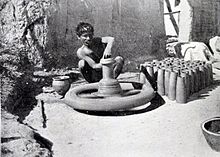
Cord-Impressed style pottery belongs to "Mesolithic" ceramic tradition that developed among Vindhya hunter-gatherers in Central India during theMesolithicperiod.[85][86]This ceramic style is also found in later Proto-Neolithic phase in nearby regions.[87]This early type of pottery, also found at the site ofLahuradewa,is currently the oldest known pottery tradition in South Asia, dating back to 7,000–6,000 BC.[88][89][90][91]Wheel-made pottery began to be made during theMehrgarhPeriod II (5,500–4,800 BC) and Merhgarh Period III (4,800–3,500 BC), known as the ceramic Neolithic andchalcolithic.Pottery, including items known as the ed-Dur vessels, originated in regions of theSaraswati River / Indus Riverand have been found in a number of sites in theIndus Civilization.[92][93] Despite an extensive prehistoric record of pottery, including painted wares, little "fine" or luxury pottery was made in the subcontinent in historic times.Hinduismdiscourages eating off pottery, which probably largely accounts for this. Most traditional Indian pottery vessels are large pots or jars for storage, or small cups or lamps, occasionally treated as disposable. In contrast there are long traditions of sculpted figures, often rather large, in terracotta; this continues with theBankura horsesinPanchmura, West Bengal.
Southeast Asia
[edit]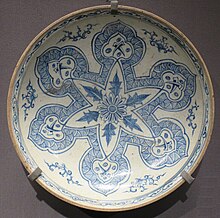
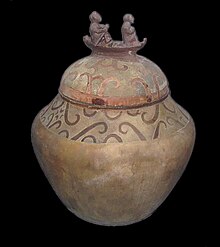
Pottery in Southeast Asia is as diverse as its ethnic groups. Each ethnic group has their own set of standards when it comes to pottery arts. Potteries are made due to various reasons, such as trade, food and beverage storage, kitchen usage, religious ceremonies, and burial purposes.[94][95][96][97]
West Asia
[edit]Around 8000 BC during thePre-pottery Neolithicperiod, and before the invention of pottery, several early settlements became experts in crafting beautiful and highly sophisticated containers from stone, using materials such asalabasterorgranite,and employing sand to shape and polish. Artisans used the veins in the material to maximum visual effect. Such objects have been found in abundance on the upperEuphrates river,in what is today eastern Syria, especially at the site ofBouqras.[98]
The earliest history of pottery production in theFertile Crescentstarts thePottery Neolithicand can be divided into four periods, namely: theHassunaperiod (7000–6500 BC), the Halaf period (6500–5500 BC), theUbaid period(5500–4000 BC), and the Uruk period (4000–3100 BC). By about 5000 BC pottery-making was becoming widespread across the region, and spreading out from it to neighbouring areas.
Pottery making began in the 7th millennium BC. The earliest forms, which were found at theHassunasite, were hand formed from slabs, undecorated, unglazed low-fired pots made from reddish-brown clays.[71]Within the next millennium, wares were decorated with elaborate painted designs and natural forms, incising and burnished.

The invention of thepotter's wheelinMesopotamiasometime between 6,000 and 4,000 BC (Ubaid period) revolutionised pottery production. Newer kiln designs could fire wares to 1,050 °C (1,920 °F) to 1,200 °C (2,190 °F) which enabled increased possibilities. Production was now carried out by small groups of potters for small cities, rather than individuals making wares for a family. The shapes and range of uses for ceramics and pottery expanded beyond simple vessels to store and carry to specialized cooking utensils, pot stands and rat traps.[99]As the region developed new organizations and political forms, pottery became more elaborate and varied. Some wares were made using moulds, allowing for increased production for the needs of the growing populations. Glazing was commonly used and pottery was more decorated.[100]
In theChalcolithicperiod in Mesopotamia,Halafian potteryachieved a level of technical competence and sophistication, not seen until the later developments ofGreek potterywith Corinthian andAttic ware.
Europe
[edit]
Europe's oldest pottery, dating from circa 6700 BC, was found on the banks of theSamara Riverin the middleVolgaregion ofRussia.[101]These sites are known as theYelshanka culture.
The early inhabitants of Europe developed pottery in theLinear Pottery cultureslightly later than the Near East, circa 5500–4500 BC. In the ancient Western Mediterranean elaborately painted earthenware reached very high levels of artistic achievement in the Greek world; there are large numbers of survivals from tombs. Minoan pottery was characterized by complex painted decoration with natural themes.[102]The classical Greek culture began to emerge around 1000 BC featuring a variety of well crafted pottery which now included the human form as a decorating motif. The pottery wheel was now in regular use. Although glazing was known to these potters, it was not widely used. Instead, a more porous clay slip was used for decoration. A widerange of shapesfor different uses developed early and remained essentially unchanged during Greek history.[103]
FineEtruscan potterywas heavily influenced by Greek pottery and often imported Greek potters and painters.Ancient Roman potterymade much less use of painting, but used moulded decoration, allowing industrialized production on a huge scale. Much of the so-called redSamian wareof the EarlyRoman Empirewas produced in modern Germany and France, where entrepreneurs established large potteries. Excavations atAugusta Raurica,near Basel, Switzerland, have revealed a pottery production site in use from the 1st to the 4th century AD.[104]
Pottery was hardly seen on the tables of elites fromHellenistictimes until theRenaissance,and most medieval wares were coarse and utilitarian, as the elites ate off metal vessels. PaintedHispano-Moresque warefrom Spain, developing the styles ofAl-Andalus,became a luxury for late medieval elites, and was adapted in Italy intomaiolicain theItalian Renaissance.Both of these werefaienceortin-glazedearthenware, and fine faience continued to be made until around 1800 in various countries, especially France, withNevers faienceand several other centres. In the 17th century, imports ofChinese export porcelainand itsJapanese equivalentraised the market expectations of fine pottery, and European manufacturers eventually learned to make porcelain, often in the form ofsoft-paste porcelain,and from the 18th century European porcelain and other wares from a great number of producers became extremely popular, reducing Asian imports.
United Kingdom
[edit]
The city ofStoke-on-Trentis widely known as "The Potteries" because of the large number of pottery factories or, colloquially, "Pot Banks". It was one of the first industrial cities of the modern era where, as early as 1785, two hundred pottery manufacturers employed 20,000 workers.[105][106]Josiah Wedgwood(1730–1795) was the dominant leader.[107]
In North Staffordshire hundreds of companies produced all kinds of pottery, from tablewares and decorative pieces to industrial items. The main pottery types of earthenware, stoneware and porcelain were all made in large quantities, and the Staffordshire industry was a major innovator in developing new varieties of ceramic bodies such asbone chinaandjasperware,as well as pioneeringtransfer printingand other glazing and decorating techniques. In general Staffordshire was strongest in the middle and low price ranges, though the finest and most expensive types of wares were also made.[108]
By the late 18th century North Staffordshire was the largest producer of ceramics in the UK, despite significant hubs elsewhere. Large export markets took Staffordshire pottery around the world, especially in the 19th century.[109]Production had begun to decline in the late 19th century, as other countries developed their industries, and declined notably after World War II. Employment fell from 45,000 in 1975 to 23,000 in 1991, and 13,000 in 2002.[110]
Arabic pottery
[edit]EarlyIslamic potteryfollowed the forms of the regions which the Arabs conquered. Eventually, however, there was cross-fertilization between the regions. This was most notable in theChinese influences on Islamic pottery.Trade between China and Islam took place via the system of trading posts over the lengthySilk Road.Middle Eastern nations imported stoneware and later porcelain from China. China imported the minerals forCobalt bluefrom the Islamic ruledPersiato decorate theirblue and white porcelain,which they then exported to the Islamic world.
Likewise, Arabic art contributed to a lasting pottery form identified asHispano-MoresqueinAndalucia.Unique Islamic forms were also developed, includingfritware,lusterwareand specialized glazes liketin-glazing,which led to the development of the popularmaiolica.[111]
One major emphasis in ceramic development in the Muslim world was the use oftileanddecorative tilework.
-
Bowl painted on slip under transparent glaze (polychrome), 9th or 10th century,Nishapur.National Museum of Iran
-
Persianmina'i warebowl with couple in a garden, around 1200. These wares are the first to useoverglaze enameldecoration.
Americas
[edit]
Most evidence points to an independent development of pottery in the Native American cultures, with the earliest known dates from Brazil, from 9,500 to 5,000 years ago and 7,000 to 6,000 years ago.[7]Further north inMesoamerica,dates begin with theArchaic Era(3500–2000 BC), and into theFormative period(2000 BC – AD 200). These cultures did not develop the stoneware, porcelain or glazes found in the Old World.Maya ceramicsinclude finely painted vessels, usually beakers, with elaborate scenes with several figures and texts. Several cultures, beginning with theOlmec,made terracotta sculpture, and sculptural pieces of humans or animals that are also vessels are produced in many places, withMoche portrait vesselsamong the finest.
Africa
[edit]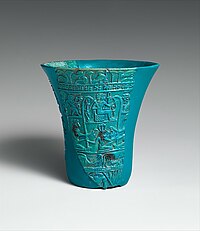
The oldest pottery in the world outside of east Asia can be found in Africa. In 2007, Swiss archaeologists discovered pieces of some of the oldest pottery inAfricaatOunjougouin the central region of Mali, dating to at least 9,400 BC.[6]Excavations in theBosumpra Caveon theKwahu Plateauin southeastern Ghana, have revealed well-manufactured pottery decorated with channelling and impressed peigne fileté rigide dating from the early tenth millennium cal. BC.[112]Following the emergence ofpottery traditionsin the Ounjougou region ofMaliaround 11,900 BP and in the Bosumpra region ofGhanasoon after, ceramics later arrived in theIho Eleruregion ofNigeria.[113]In later periods, a relationship of the introduction of pot-making in some parts ofSub-Saharan Africawith the spread ofBantu languageshas been long recognized, although the details remain controversial and awaiting further research, and no consensus has been reached.[13]
Oceania
[edit]Polynesia,MelanesiaandMicronesia
Pottery has been found in archaeological sites across the islands of Oceania. It is attributed to an ancient archaeological culture called theLapita.Another form of pottery calledPlainwareis found throughout sites of Oceania. The relationship between Lapita pottery and Plainware is not altogether clear.
TheIndigenous Australiansnever developed pottery.[114]After Europeans came to Australia and settled, they found deposits of clay which were analysed by English potters as excellent for making pottery. Less than 20 years later, Europeans came to Australia and began creating pottery. Since then, ceramic manufacturing, mass-produced pottery and studio pottery have flourished in Australia.[115]
See also
[edit]References
[edit]- ^'Standard Terminology Of Ceramic Whitewares And Related Products.' ASTM C 242–01 (2007.)ASTM International.
- ^"terracottas (sculptural works)",Getty Art & Architecture Thesaurus
- ^abLienhard, John H. (November 24, 1989)."No. 359: The Dolni Vestonice Ceramics".The Engines of Our Ingenuity.University of Houston. Archived fromthe originalon January 9, 2010.RetrievedSeptember 4,2010.
- ^Diamond, Jared (June 1998)."Japanese Roots".Discover.Discover Media LLC.Archivedfrom the original on 2010-03-11.Retrieved2010-07-10.
- ^abc'AMS 14C Age Of The Earliest Pottery From The Russian Far East; 1996–2002.' Derevianko A.P., Kuzmin Y.V., Burr G.S., Jull A.J.T., Kim J.C. Nuclear Instruments And Methods In Physics Research. B223–224 (2004) 735–39.
- ^abcdSimon Bradley,A Swiss-led team of archaeologists has discovered pieces of the oldest African pottery in central Mali, dating back to at least 9,400BCArchived2012-03-06 at theWayback Machine,SWI swissinfo.ch – the international service of the Swiss Broadcasting Corporation (SBC), 18 January 2007
- ^abcRoosevelt, Anna C. (1996). "The Maritime, Highland, Forest Dynamic and the Origins of Complex Culture". In Frank Salomon; Stuart B. Schwartz (eds.).The Cambridge History of the Native Peoples of the Americas.Cambridge, England New York: Cambridge University Press. pp. 264–349.ISBN978-0-521-63075-7.Archivedfrom the original on 2019-12-07.Retrieved2019-10-17.
- ^abHeck, Mary-Frances."The Food & Wine Guide to Clay Pot Cooking".Food & Wine.Retrieved2022-01-26.
- ^"Art & Architecture Thesaurus Full Record Display (Getty Research)".Getty.edu.Archivedfrom the original on 22 December 2017.Retrieved30 April2018.
- ^abCooper (2010), p. 54
- ^Crabtree, Pamela, ed.,Medieval Archaeology,Routledge Encyclopedias of the Middle Ages, 2013, Routledge,ISBN1-135-58298-X,9781135582982,google booksArchived2018-10-10 at theWayback Machine
- ^Cooper (2010), pp. 72–79, 160–79
- ^abSeeBostoen, Koen (2007),"Pots, Words and the Bantu Problem: On Lexical Reconstruction and Early African History",The Journal of African History,48(2): 173–199,doi:10.1017/S002185370700254X,hdl:1854/LU-446281,JSTOR4501038,S2CID31956178for a recent discussion of the issues, and links to further literature.
- ^abcdSeeGosselain, Olivier P. (2000), "Materializing Identities: An African Perspective",Journal of Archaeological Method and Theory,7(3): 187–217,doi:10.1023/A:1026558503986,JSTOR20177420,S2CID140312489for further discussion and sources.
- ^Fabric AnalysisArchived2021-07-11 at theWayback Machine,cambridge.org, accessed 10 July 021.
- ^Ruth M. Home, "Ceramics for the Potter", Chas. A. Bennett Co., 1952
- ^"China Clay".www.thepotteries.org.Retrieved2024-10-01.
- ^Home, 1952, p. 16
- ^Whitewares: Production, Testing And Quality Control.Ryan w. & Radford C. Pergamon Press. 1987
- ^"Why On Earth Do They Call It Throwing? | Contractor Quotes".June 12, 2019. Archived fromthe originalon February 3, 2007.
- ^ab"Whitewares: Production, Testing And Quality Control." W.Ryan & C.Radford.Pergamon Press.1987
- ^Two Centuries of Hellenistic Pottery Homer A. Thompson. Vol. 3, No. 4, The American Excavations in the Athenian Agora: Fifth Report (1934), pp. 311-476. The American School of Classical Studies at Athens
- ^New Zealand Potter. Vol. 30 No. 1 1988, pp. 7
- ^Forming Techniques - for the Self-Reliant Potter. Henrik Norsker, James Danisch. Vieweg+1991.Teubner Verlag Wiesbaden
- ^Using Polymers as a Binder for Improvement of Mechanical Strength of Tableware in Isostatics Press Technology. A. Arasteh Nodeh. Iranian Chemical Engineering Journal – Vol.9 - No. 48 (2010)
- ^Control And Automation In The Ceramic Industry Evolution. José Gustavo Mallol Gasch. Ceramic Forum International. December 2007 84 (12):E55-E57
- ^Reference Document On Best Available Techniques In The Ceramic Manufacturing Industry. European Commission August 2007
- ^An Introduction To The Technology Of Pottery. Paul Rado. Pergamon Press. 1969
- ^'Sanitaryware Technology'. Domenico Fortuna. Gruppo Editoriale Faenza Editrice S.p.A. 2000.
- ^"DGM-E.pdf"(PDF).Retrieved2010-09-04.[permanent dead link]
- ^"Ceramicindustry.com".Ceramic industries.com.2000-11-21. Archived fromthe originalon 2011-07-08.Retrieved2010-09-04.
- ^Dictionary Of Ceramics.Arthur Dodd & David Murfin. 3rd edition. The Institute Of Minerals. 1994.
- ^Operations Optimization Of RAM Press Machine By Frame Assembly Techniques. Pairoj Bootpeng, Yuttapong Naksopon, Nuttawut Pebkhuntod, Pattana Charuenying, And Pakawadee Sirilar. Suranaree J. Sci. Technol. 21(2):105-109
- ^"Novel Approach To Injection Moulding." M.Y.Anwar, P.F. Messer, H.A. Davies, B. Ellis. Ceramic Technology International 1996.Sterling Publications Ltd.,London, 1995. pp. 95–96, 98.
- ^ab"Injection Moulding Of Porcelain Pieces." A. Odriozola, M.Gutierrez, U.Haupt, A.Centeno.Bol. Soc. Esp. Ceram.Vidrio 35, No. 2, 1996. pp. 103–07
- ^"Injection Moulding Of Cups With Handles." U.Haupt.International Ceramics.No. 2, 1998, pp. 48–51.
- ^"Injection Moulding Technology In Tableware Production."Ceramic World Review.13, No. 54, 2003. pp. 94, 96–97.
- ^Research on The Application of Ceramic 3D Printing Technology. Bin Zhao. March 2021 Journal of Physics Conference Series 1827(1):012057
- ^From Control To Uncertainty In 3d Printing With Clay. Benay Gürsoy. Computing For A Better Tomorrow. Education And Research In Computer Aided Architectural Design In Europe. Pp. 21-30. 2018
- ^'The Application Of Injection Moulding Technology In Modern Tableware Production. 'P. Quirmbach, S. Schwartz, F. Magerl. Ceramic Forum International 81(3):E24-E31, 2004
- ^"Quick Tip: Reconstituting Clay".Default.Retrieved2024-10-01.
- ^Kim (2012-04-02)."Need to know: Stages of drying in clay".ClayGeek.Retrieved2024-10-01.
- ^"The 6 different stages of clay".Oxford Clay Handmade Ceramics - Eco-conscious pottery.Retrieved2024-10-01.
- ^ab'The Emergence Of Ceramic Technology And Its Evolution As Revealed With The Use Of Scientific Techniques.' Y. Maniatis. Mine to Microscope: Advances in the Study of Ancient. (ed. A.J. Shortland, I.C. Freestone and T. Rehren ) Oxbow Books, Oxford, (2009). Chapter 2.
- ^ab'The Firing Of Clay-Based Ceramics.' W. H. Holmes. Science Progress. Vol. 60, No. 237 (Spring 1972), pg. 98
- ^Sutton, W.H. Microwave Processing of Ceramics – An Overview. MRS Online Proceedings Library 269, 3–20 (1992).
- ^"History of Pottery".Brothers-handmade.com.Archived fromthe originalon 2013-06-01.Retrieved2010-09-04.
- ^Malaxi Teams."Labu Sayong, Perak".Malaxi.com.Archived fromthe originalon 2012-11-04.Retrieved2010-09-04.
- ^Goldner, Janet (Spring 2007). "The women of Kalabougou".African Arts.40(1): 74–79.doi:10.1162/afar.2007.40.1.74.S2CID57567441.
- ^"The Fast Firing Of Biscuit Earthenware Hollow-Ware In a Single-Layer Tunnel Kiln." Salt D.L. Holmes W.H. RP737.Ceram Research.
- ^"New And Latest Biscuit Firing Technology". Porzellanfabriken Christian Seltmann GmbH.Ceram.Forum Int./Ber.DKG 87, No. 1/2, pp. E33–E34, E36. 2010
- ^"Clay Sewer Pipe Manufacture. Part II – The Effect Of Variable Alumina, Silica And Iron Oxide In Clays On Some Properties Of Salt Glazes." H.G. Schurecht.The Journal of the American Ceramic Society.Volume 6. Issue 6, pp. 717–29.
- ^"Dictionary Of Ceramics." Arthur Dodd & David Murfin. 3rd edition.The Institute Of Minerals.1994.
- ^"Ash Glaze Research." C. Metcalfe.Ceramic ReviewNo. 202. 2003. pp. 48–50.
- ^"Glaze From Wood Ashes And Their Colour Characteristics." Y-S. Han, B-H. Lee.Korean Ceramic Society41. No. 2. 2004.
- ^"Stoke Museums – Health Risks in a Victorian Pottery Industry".7 July 2012. Archived fromthe originalon 7 July 2012.Retrieved23 February2022.
- ^"Timeline – History of Occupational Safety and Health".
- ^'The Successful Prevention Of Silicosis Among China Biscuit Workers In The North Staffordshire Potteries.' A. Meiklejohn. British Journal Of Industrial Medicine, October 1963; 20(4): 255–263
- ^'A Case Of Silicosis In The Ceramic Sector. Y. Yurt, M. Turk. EJMI. 2018; 2(1): 50–52
- ^Silicosis,nhs.uk
- ^Cancer warning: The type of dust linked to a higher risk of lung cancer – 'harmful',express.co.uk, 12 July 2022
- ^"The Pottery (Health and Welfare) Special Regulations 1950".
- ^'Whitewares: Production, Testing And Quality Control. "W.Ryan & C.Radford. Pergamon Press. 1987
- ^"Is Pottery Clay Eco-Friendly? – or is it Costing the Earth?".Pottery Tips by the Pottery Wheel.2020-07-14.Retrieved2022-05-10.
- ^William K. Barnett and John W. Hoopes,The Emergence of Pottery: Technology and Innovation in Ancient Society,Smithsonian Institution Press, 1995, p. 19
- ^Metropolitan Museum of Art"Jomon Culture (Ca. 10,500-ca. 300 B.C.) | Thematic Essay | Heilbrunn Timeline of Art History | the Metropolitan Museum of Art".Archivedfrom the original on 2011-09-06.Retrieved2011-09-15.
- ^Haarmann, Harald(2020).Advancement in Ancient Civilizations: Life, Culture, Science and Thought.Jefferson, North Carolina: McFarland & Company, Inc., Publishers. p. 40.ISBN978-1-4766-4075-4.
- ^Glenn C. Nelson, Ceramics: A Potter's Handbook,1966, Holt, Rinehart and Winston, Inc., p. 251
- ^Cooper (2010)
- ^Nelson (1966), p. 251
- ^abCooper (2010), p. 16
- ^Bar-Yosef, Ofer; Arpin, Trina; Pan, Yan; Cohen, David; Goldberg, Paul; Zhang, Chi; Wu, Xiaohong (29 June 2012). "Early Pottery at 20,000 Years Ago in Xianrendong Cave, China".Science.336(6089): 1696–1700.Bibcode:2012Sci...336.1696W.doi:10.1126/science.1218643.ISSN0036-8075.PMID22745428.S2CID37666548.
- ^Marshall, Michael (2012)."Oldest pottery hints at cooking's ice-age origins".New Scientist.215(2872): 14.Bibcode:2012NewSc.215Q..14M.doi:10.1016/S0262-4079(12)61728-X.Archivedfrom the original on 2019-10-20.Retrieved2019-05-10.
- ^ab"Chinese pottery may be earliest discovered."Archived2012-10-06 at theWayback MachineAssociated Press.2009-06-01.
- ^"Remnants of an Ancient Kitchen Are Found in China"Archived2017-03-15 at theWayback Machine.The New York Times.
- ^Wu, X.; Zhang, C.; Goldberg, P.; Cohen, D.; Pan, Y.; Arpin, T.; Bar-Yosef, O. (June 29, 2012). "Early Pottery at 20,000 Years Ago in Xianren Cave, China".Science.336(6089): 1696–700.Bibcode:2012Sci...336.1696W.doi:10.1126/science.1218643.PMID22745428.S2CID37666548.
- ^"Harvard, BU researchers find evidence of 20,000-year-old pottery"Archived2017-07-28 at theWayback Machine.The Boston Globe.
- ^'Radiocarbon Dating Of Charcoal And Bone Collagen Associated With Early Pottery At Yuchanyan Cave, Hunan Province, China.' Boaretto E., Wu X., Yuan J., Bar-Yosef O., Chu V., Pan Y., Liu K., Cohen D., Jiao T., Li S., Gu H., Goldberg P., Weiner S. Proceedings of the National Academy of Sciences USA. June 2009. 16;106(24): 9595–600.
- ^Kainer, Simon (September 2003)."The Oldest Pottery in the World"(PDF).Current World Archaeology.Robert Selkirk. pp. 44–49. Archived from the original on 2006-04-23.Retrieved2016-09-27.
{{cite news}}:CS1 maint: bot: original URL status unknown (link) - ^abO.E. Craig, H. Saul, A. Lucquin, Y. Nishida, K. Taché, L. Clarke, A. Thompson, D.T. Altoft, J. Uchiyama, M. Ajimoto, K. Gibbs, S. Isaksson, C.P. Heron P. Jordan (18 April 2013). "Earliest evidence for the use of pottery".Nature.496(7445): 351–54.arXiv:1510.02343.Bibcode:2013Natur.496..351C.doi:10.1038/nature12109.hdl:10454/5947.PMID23575637.S2CID3094491.
{{cite journal}}:CS1 maint: multiple names: authors list (link) - ^Barnett & Hoopes 1995:211
- ^Cooper (2010), p. 75
- ^Cooper (2010), p. 79
- ^Cooper (2010), pp. 160–62
- ^D. Petraglia, Michael (26 March 2007).The Evolution and History of Human Populations in South Asia(2007 ed.). Springer. p. 407.ISBN9781402055614.Archivedfrom the original on 1 January 2014.Retrieved26 March2007.
- ^Bulletin of the Deccan College Research Institute, Volume 49, Dr. A. M. Ghatage, Page 303–304
- ^Upinder Singh (2008).A History of Ancient and Early Medieval India: From the Stone age to the 12th century.Pearson Education India. p. 76.ISBN9788131716779.Archivedfrom the original on 2020-12-14.Retrieved2020-06-04.
- ^Peter Bellwood; Immanuel Ness (2014-11-10).The Global Prehistory of Human Migration.John Wiley & Sons. p. 250.ISBN9781118970591.Archivedfrom the original on 2020-07-28.Retrieved2020-06-04.
- ^Gwen Robbins Schug; Subhash R. Walimbe (2016-04-13).A Companion to South Asia in the Past.John Wiley & Sons. p. 350.ISBN9781119055471.Archivedfrom the original on 2021-07-01.Retrieved2020-06-04.
- ^Barker, Graeme; Goucher, Candice (2015).The Cambridge World History: Volume 2, A World with Agriculture, 12,000 BCE–500 CE.Cambridge University Press. p. 470.ISBN9781316297780.Archivedfrom the original on 2020-07-28.Retrieved2019-10-21.
- ^Cahill, Michael A. (2012).Paradise Rediscovered: The Roots of Civilisation.Interactive Publications. p. 104.ISBN9781921869488.
- ^Proceedings,American Philosophical Society(vol. 85, 1942).ISBN1-4223-7221-9
- ^Archaeology of the United Arab Emirates: Proceedings of the First International Conference on the Archaeology of the U.A.E. By Daniel T. Potts, Hasan Al Naboodah, Peter Hellyer. Contributor Daniel T. Potts, Hasan Al Naboodah, Peter Hellyer. Published 2003. Trident Press Ltd.ISBN1-900724-88-X
- ^The pottery trail from Southeast Asia to remote Oceania, MT Carson, H Hung, G Summerhayes, 2013
- ^The incised & impressed pottery style of mainland Southeast Asia: following the paths of Neolithization F Rispoli – East and West, 2007
- ^Sa-huỳnh Related Pottery in Southeast Asia WG Solheim – Asian Perspectives, 1959
- ^The Kulanay pottery complex in the Philippines WG Solheim – Artibus Asiae, 1957
- ^"Metropolitan Museum of Art".Metmuseum.org.Archivedfrom the original on 2019-04-22.Retrieved2019-04-26.
- ^Cooper (2010), pp. 19–20
- ^Cooper (2010), pp. 20–24
- ^D. W. Anthony.The Horse, the Wheel, and Language.P. 149.
- ^Cooper (2010), pp. 36–37
- ^Cooper (2010), p. 42
- ^"Deutsches Museum: History".Archived fromthe originalon 2016-07-07."Deutsches Museum: History".Archived from the original on 2019-12-28.Retrieved2021-12-31.
{{cite web}}:CS1 maint: bot: original URL status unknown (link) - ^Richard Whipp,Patterns of Labour – Work and Social Change in the Pottery Industry(1990).
- ^Simeon Shaw,History of the Staffordshire Potteries: And the Rise and Progress of the Manufacture of Pottery and Porcelain; with References to Genuine Specimens, and Notices of Eminent Potters(1900)online.
- ^Brian Dolan,Wedgwood: The First Tycoon(2004).
- ^Aileen Dawson, "" The Growth of the Staffordshire Ceramic Industry ", in Freestone, Ian,Gaimster, David R. M.(eds),Pottery in the Making: World Ceramic Traditions(1997), pp 200–205
- ^Dawson, 200–201
- ^Ridge, Mian (29 May 2002)."Gone to pot".The Guardian.
- ^Nelson (1966), pp. 23–26
- ^Watson, Derek J. (2 October 2017)."Bosumpra revisited: 12,500 years on the Kwahu Plateau, Ghana, as viewed from" On top of the hill "".Azania: Archaeological Research in Africa.52(4): 437–517.doi:10.1080/0067270X.2017.1393925.S2CID165755536.
- ^Cerasoni, Jacopo Niccolò; et al. (17 March 2023)."Human interactions with tropical environments over the last 14,000 years at Iho Eleru, Nigeria".iScience.26(3): 106153.Bibcode:2023iSci...26j6153C.doi:10.1016/j.isci.2023.106153.ISSN2589-0042.OCLC9806331324.PMC9950523.PMID36843842.S2CID256747182.
- ^"Aboriginal Culture: Introduction".Archived fromthe originalon March 16, 2015.
- ^"History of Australian Pottery".Archived fromthe originalon March 17, 2012.
Further reading
[edit]- ASTM Standard C 242-01Standard Terminology of Ceramic Whitewares and Related Products
- Ashmore, Wendy & Sharer, Robert J., (2000).Discovering Our Past: A Brief Introduction to Archaeology Third Edition.Mountain View, CA: Mayfield Publishing Company.ISBN978-0-07-297882-7
- Barnett, William & Hoopes, John (Eds.) (1995).The Emergence of Pottery.Washington: Smithsonian Institution Press.ISBN1-56098-517-8
- Childe, V.G., (1951).Man Makes Himself.London: Watts & Co.
- Freestone, Ian, Gaimster, David R.M.,Pottery in the Making: World Ceramic Traditions,1997, British Museum Publications,ISBN0-7141-1782-X
- Rice, Prudence M. (1987).Pottery Analysis – A Sourcebook.Chicago: University of Chicago Press.ISBN0-226-71118-8.
- Savage, George,Pottery Through the Ages,Penguin, 1959,ISBN9789120063317



